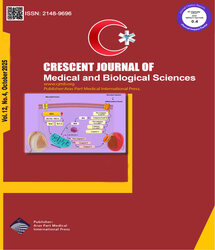
| Original Article | |
| Postpartum Acquired Haemophilia A and Post-partum Life-Threatening Haemorrhage Following COVID-19 Infection: A Case Report | |
| Saghar Salehpour1, Mohammad Hassani2, Seyedeh Mojgan Ghalandarpoor-Attar3, Hamed Azhdari Tehrani4, Elena Ghotbi1, Azadeh Shabani1, Mojtaba Ghadiany4 | |
| 1Preventive Gynecology Research Center (PGRC), Taleghani Hospital, Shahid Beheshti University of Medical Sciences, Tehran, Iran 2Department of Vascular and Endovascular Surgery, Ayatollah Taleghani Hospital Research Development Committee, Shahid Beheshti University of Medical Sciences, Tehran, Iran 3Obstetrics and Gynecology Department, Baharloo Hospital, Tehran University of Medical Sciences, Tehran, Iran 4Hematology and Oncology Department, Taleghani Hospital, Shahid Beheshti University of Medical Sciences, Tehran, Iran |
|
|
DOI: 10.34172/cjmb.2024.3019 Viewed : 3863 times Downloaded : 4186 times. Keywords : Hemophilia A, COVID-19, Postpartum haemorrhage, Case reports, Blood coagulation disorders, Pregnancy |
|
| Full Text(PDF) | Related Articles | |
| Abstract | |
Objectives: Although there is a significant number of reports regarding acquired haemophilia A (AHA) following COVID-19 infection in non-pregnant females, and especially in elderly males, there is a lack of data on similar cases among pregnant or postpartum women. Here, we present a case of confirmed COVID-19-induced life-threating postpartum haemorrhage (PPH) and share some diagnostic challenges leading to severe maternal morbidities. Case Presentation: A 32-year-old woman came to the emergency department with massive vaginal bleeding on 13th day of post-elective cesarean section (CS). Her hemodynamic condition got rapidly deteriorated and haemorrhagic shock occurred. She had no comorbidities in her two gestations and obstetrical and systemic physical examinations were unremarkable except for ongoing massive vaginal bleeding and the findings were compatible with haemorrhagic shock. The Primary Diagnoses, Interventions, and Outcomes: Emergent hysterectomy was performed after first line PPH medical treatment failure, and clinical status got worse. Additionally, as the patient had close contact with a confirmed COVID-19 infected case and a low-grade fever was detected, nasopharyngeal swab and chest CT-scan were taken. The results were in favour of infection. Partial thromboplastin time (PTT) was also prolonged, which was initially assumed due to excessive bleeding. Returning PTT to normal values after blood products transfusion enhanced our diagnosis as well. Since endometritis and subinvolution of placental sites were the two most suspicious diagnoses, the standard treatment protocol was applied. Additionally, due to COVID-19 pulmonary involvement, antiviral therapy was also initiated. Finally, the patient was discharged in good condition. Again, on 28th day of post-CS, she referred with abdominal distension and malaise and a second laparotomy was considered due to a retractable large intraperitoneal haematoma and skin site bleeding. PTT was again prolonged, which was not corrected after blood products transfusion. Hence, recombinant factor seven was also transfused. At last, since bleeding recurred and coagulation profile deteriorated in second postoperative period, she was transferred to a tertiary centre. A third laparotomy was done as another life-threating resistant intraperitoneal bleeding re-occurred. Next, due to persistent prolonged PTT, hematologic consultation was done. AHA was suspected due to recent viral infection by COVID-19. Activated PTT (aPTT) mixing test and competitive inhibitory antibodies assay confirmed the diagnosis of COVID-19-induced postpartum acquired haemophilia A (PPAHA). Subsequently, full-dose immunosuppressive therapy was initiated and PTT reached normal values after 8 days. Conclusions: We highly recommend close monitoring of coagulopathy by doing complete blood cell count, aPTT, and prothrombin time in postpartum period of COVID-19 infected women even in women without abnormal bleeding in immediate postpartum period. Patient follow-ups and awareness of possible COVID-19-induced AHA in peri-partum population can reduce maternal morbidity and mortality. |
Cite By, Google Scholar
Google Scholar
PubMed
Online Submission System
 CJMB ENDNOTE ® Style
CJMB ENDNOTE ® Style
 Tutorials
Tutorials
 Publication Charge
Medical and Biological Research Center
About Journal
Publication Charge
Medical and Biological Research Center
About Journal
Aras Part Medical International Press Editor-in-Chief
Arash Khaki
Deputy Editor
Zafer Akan


















